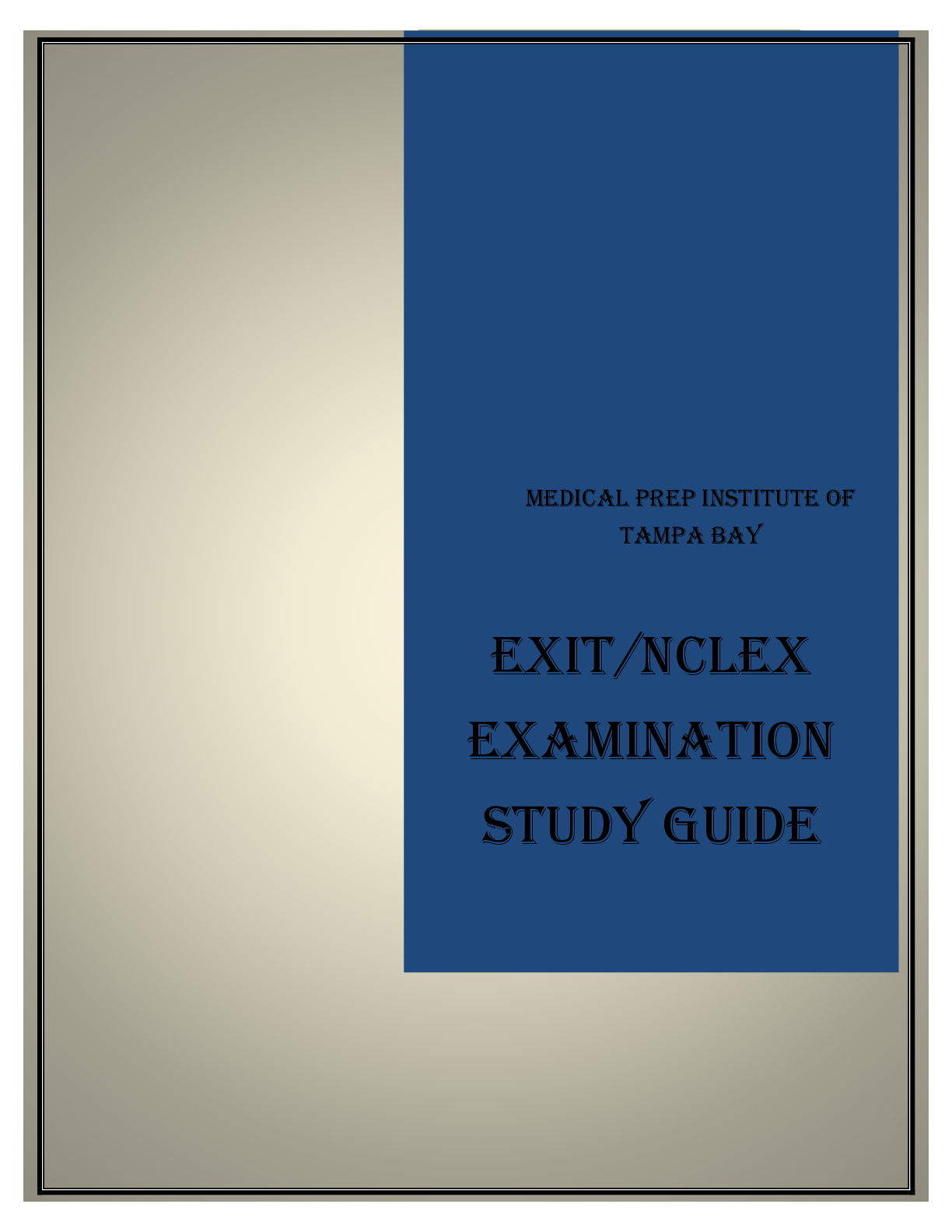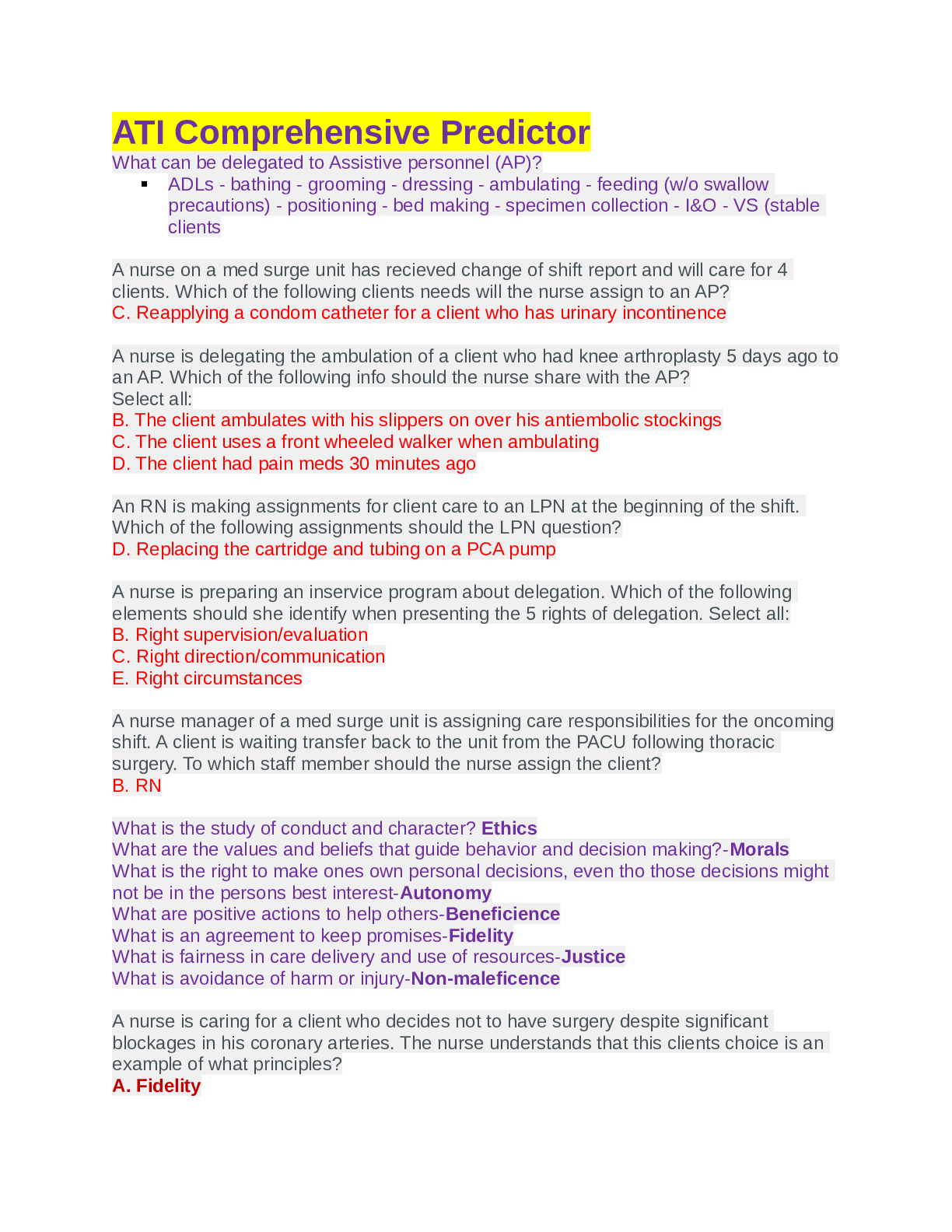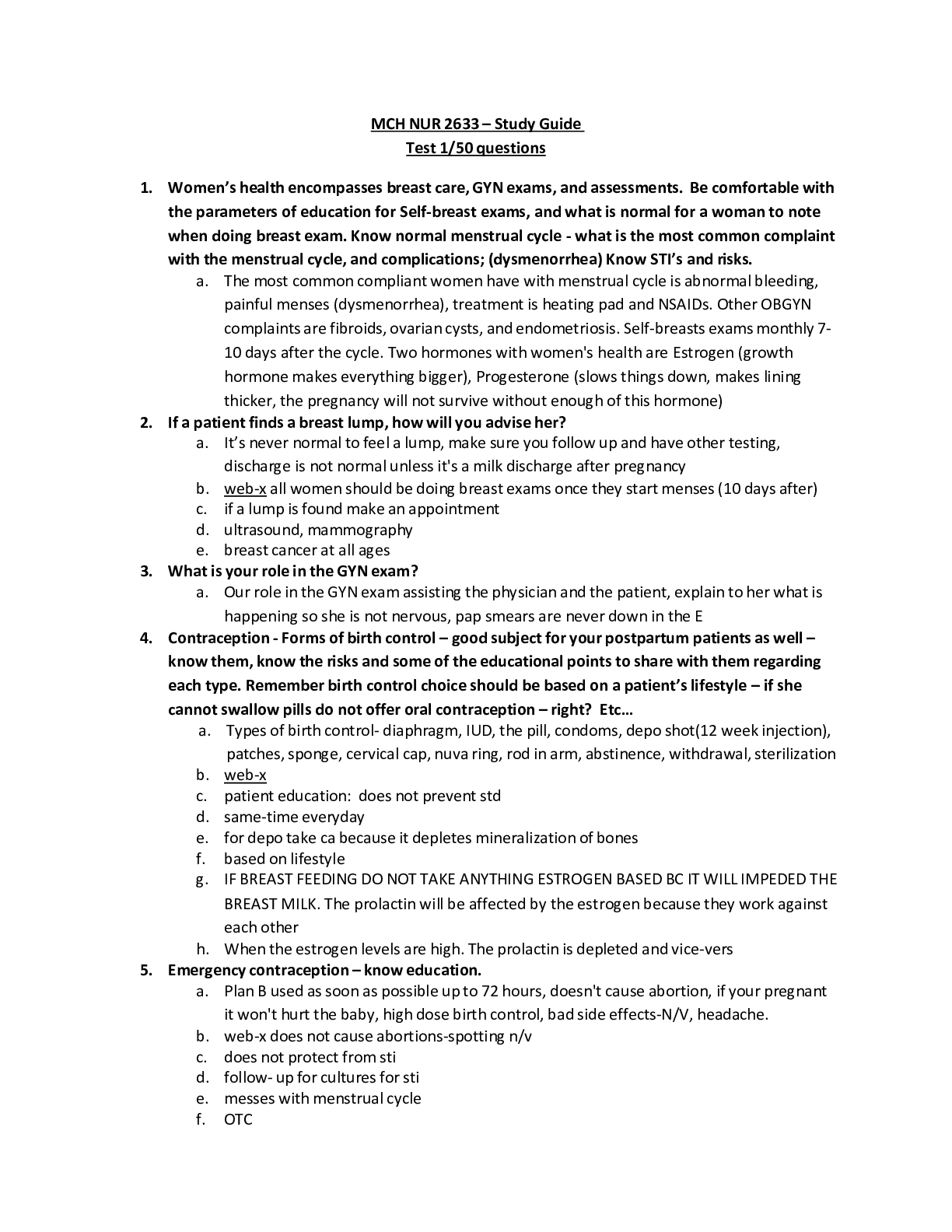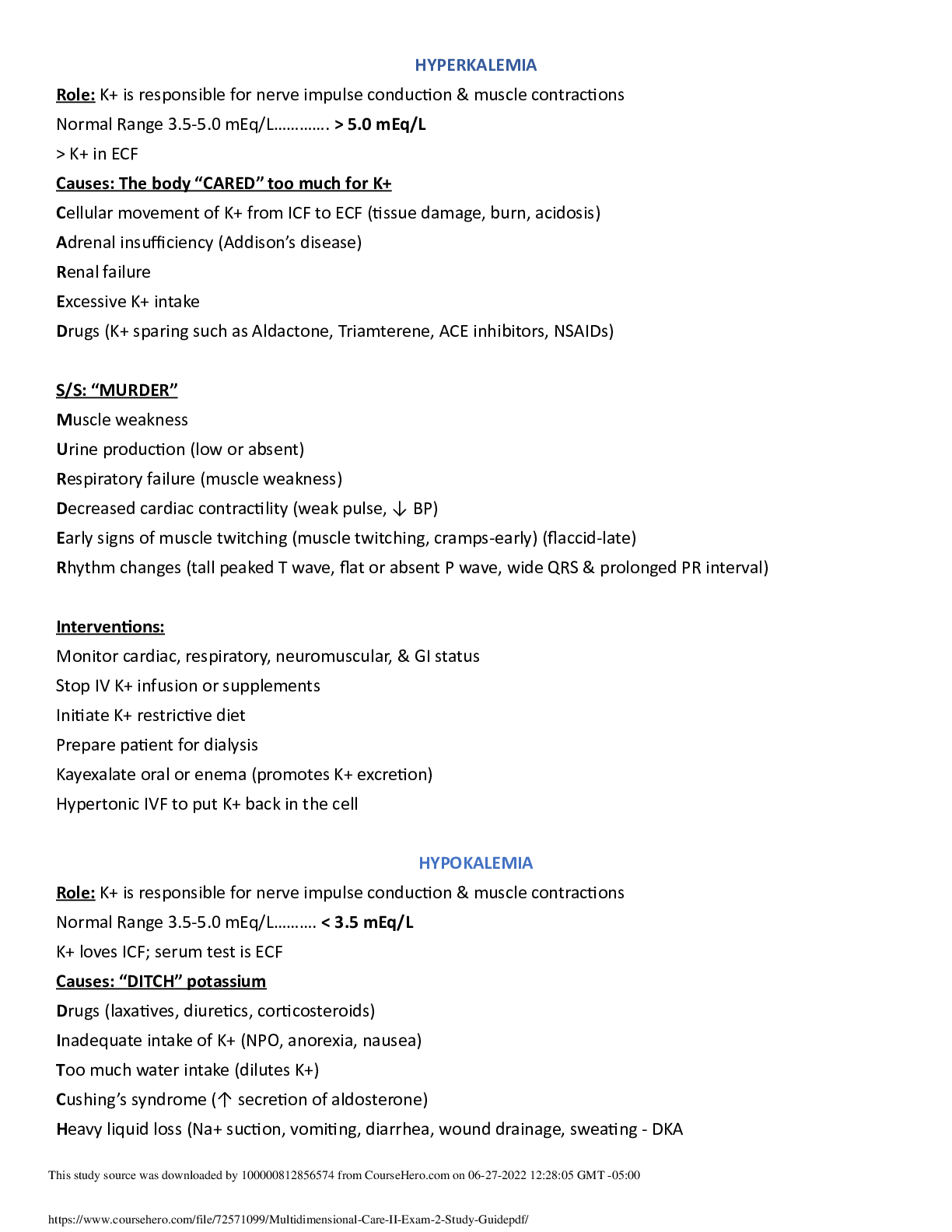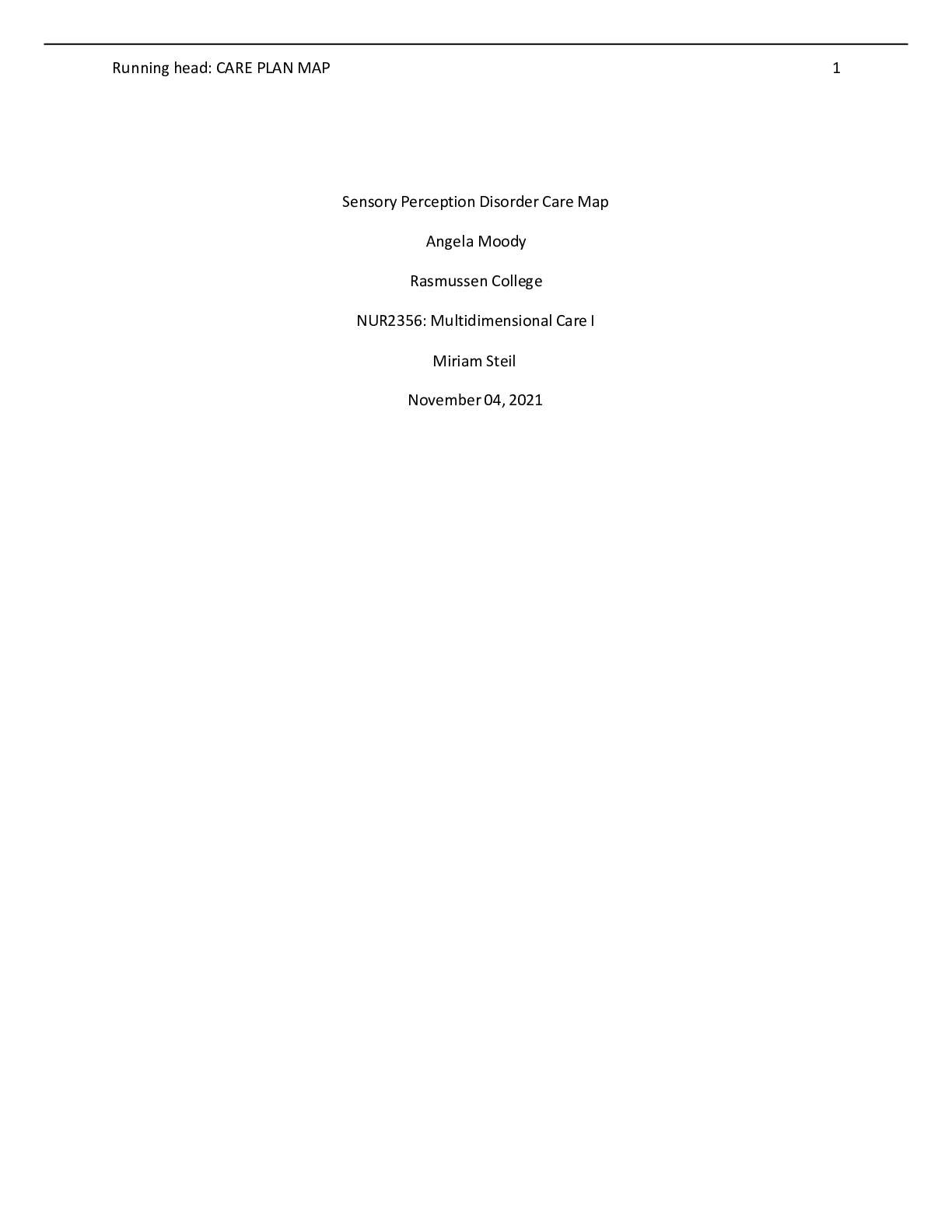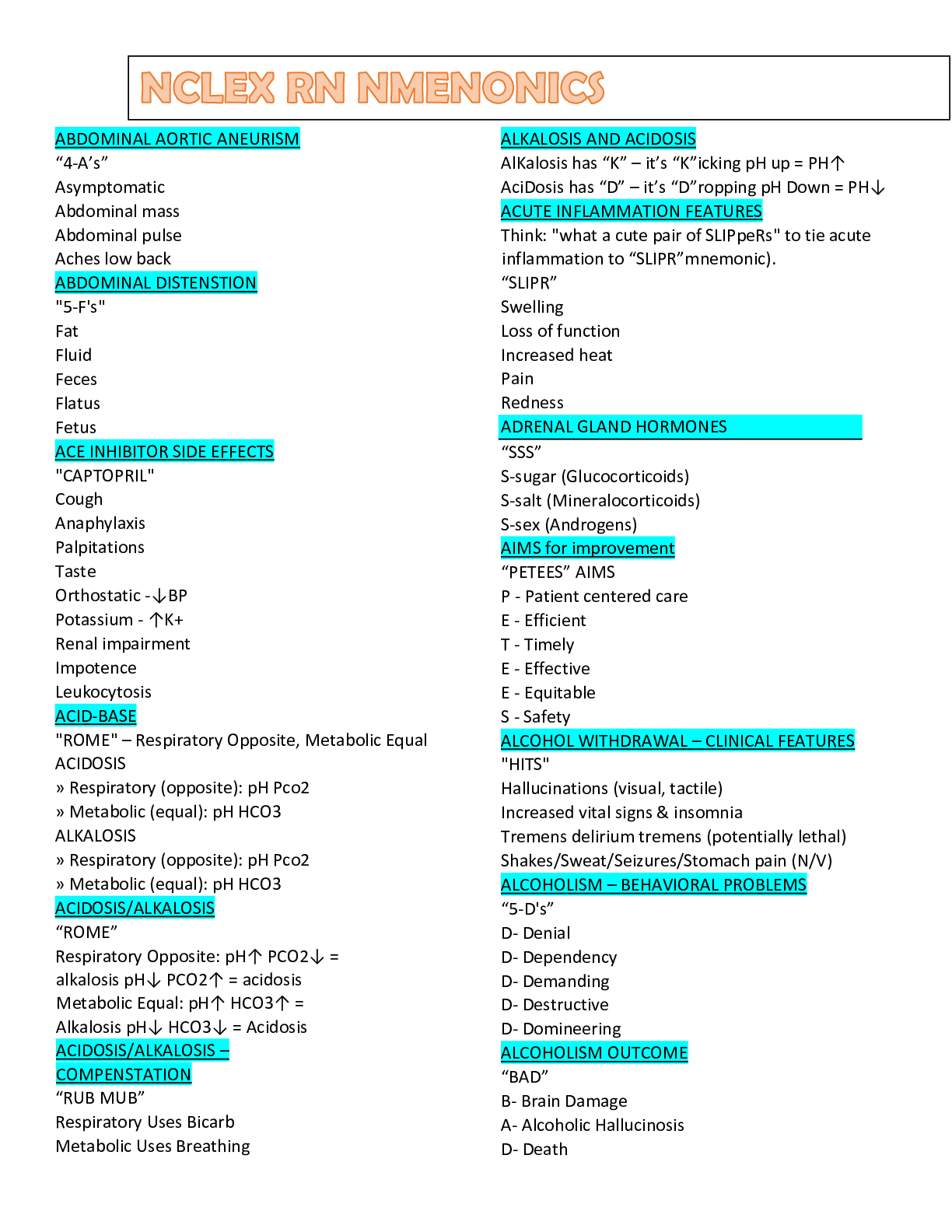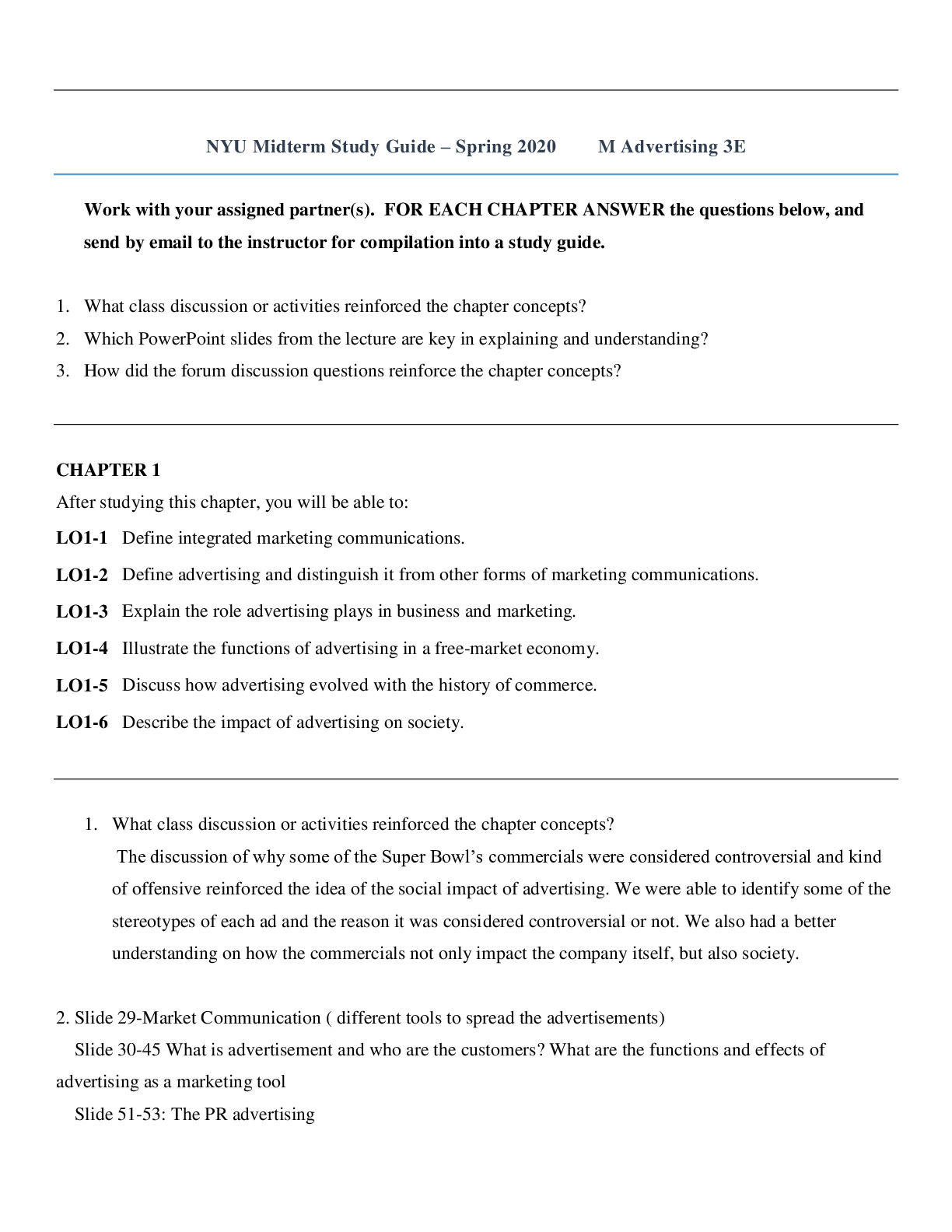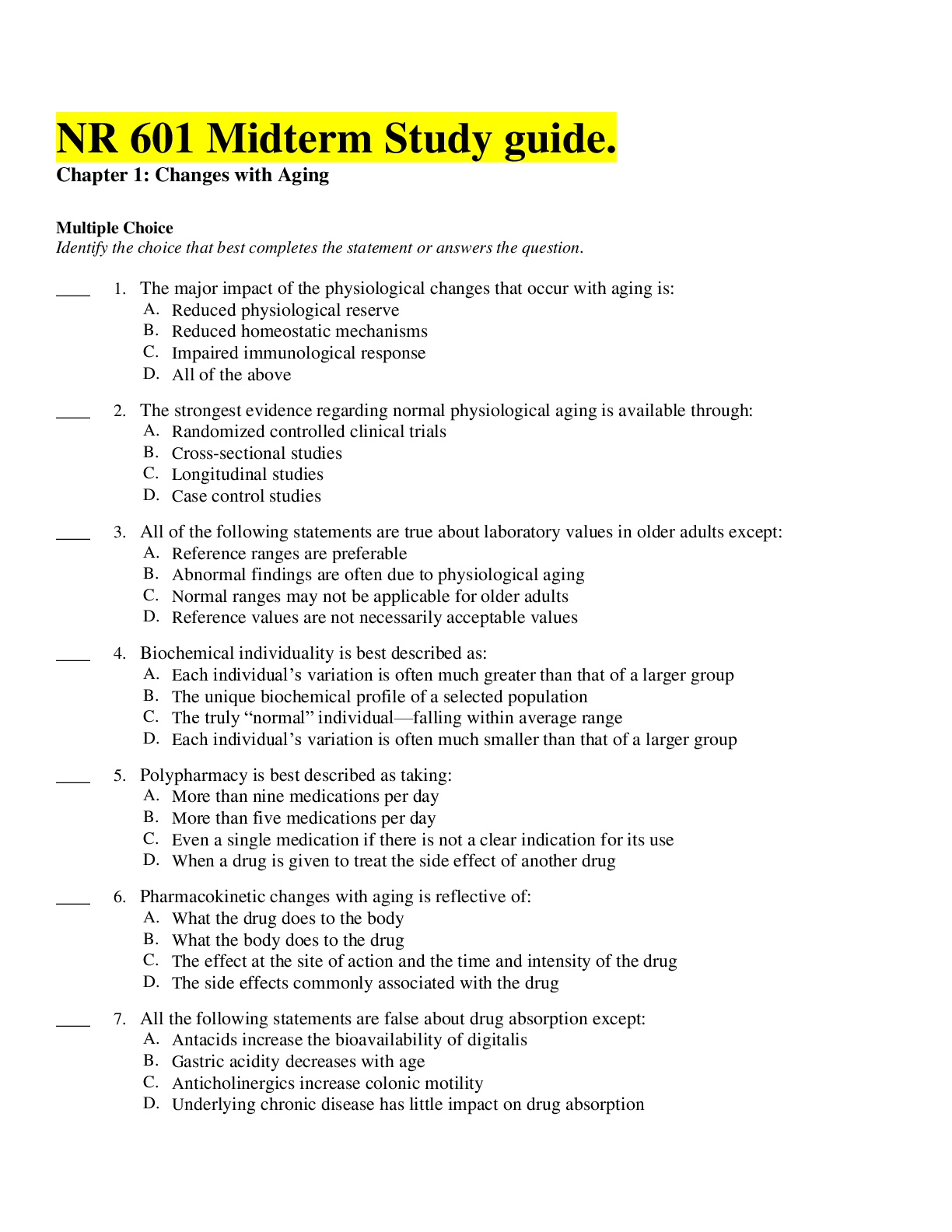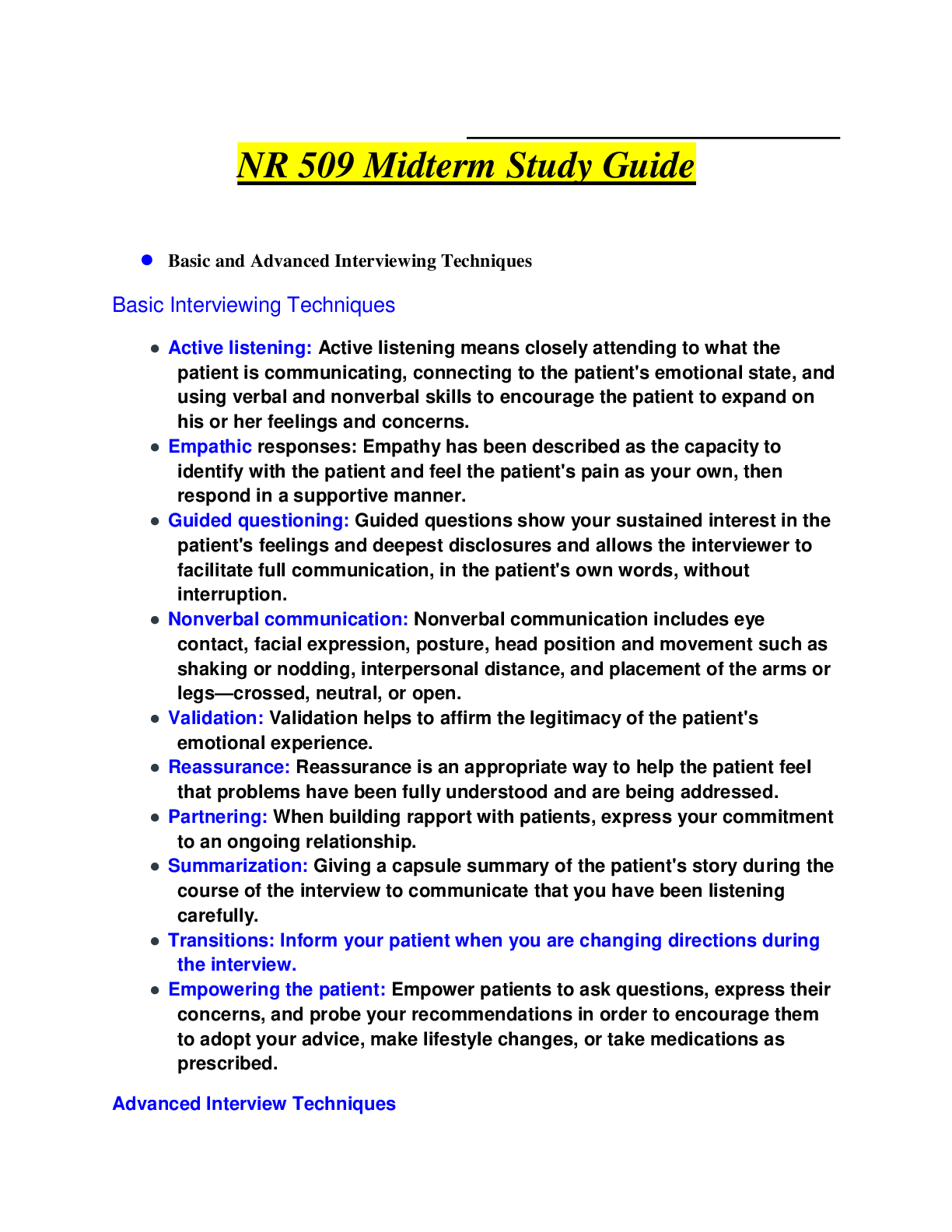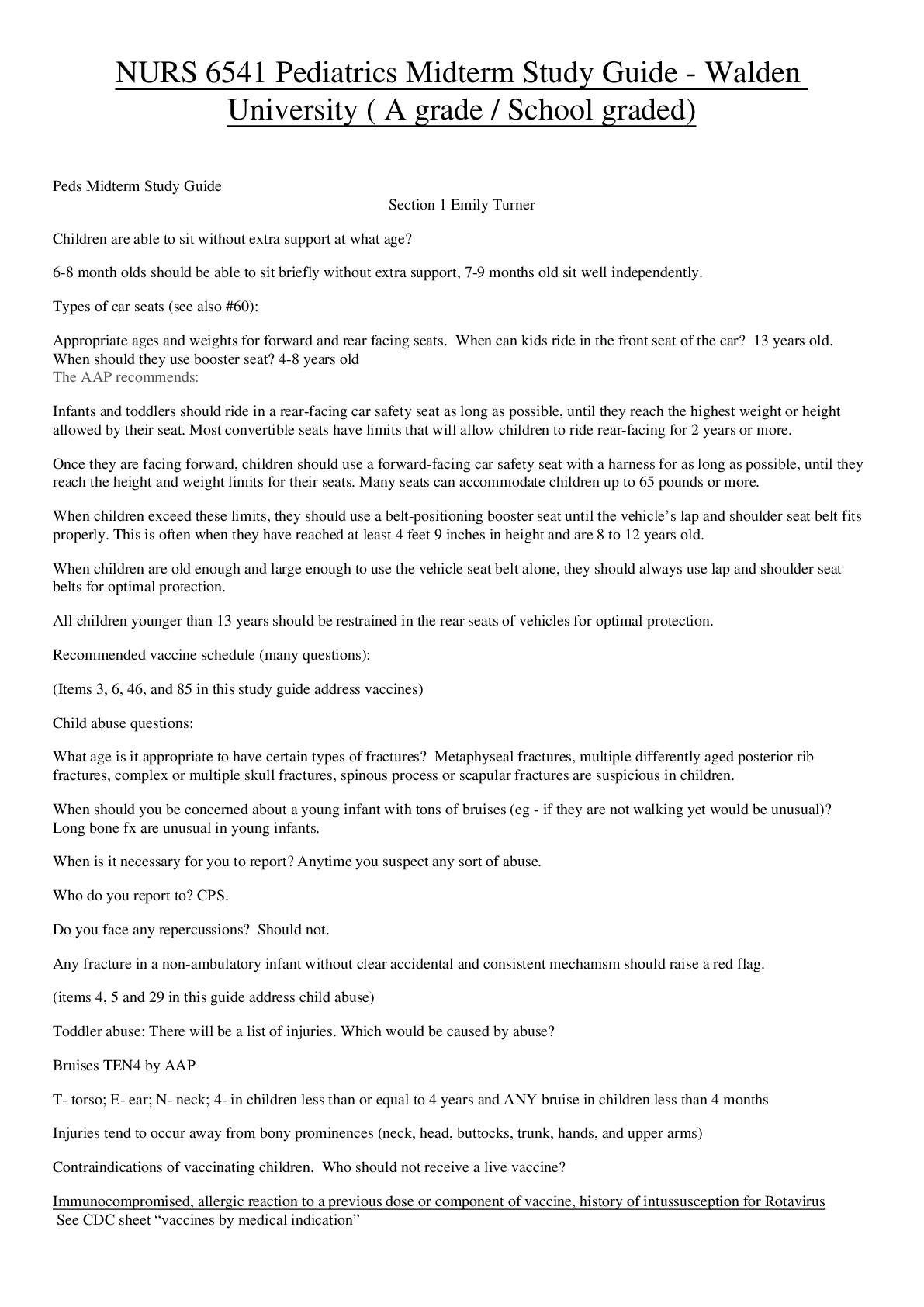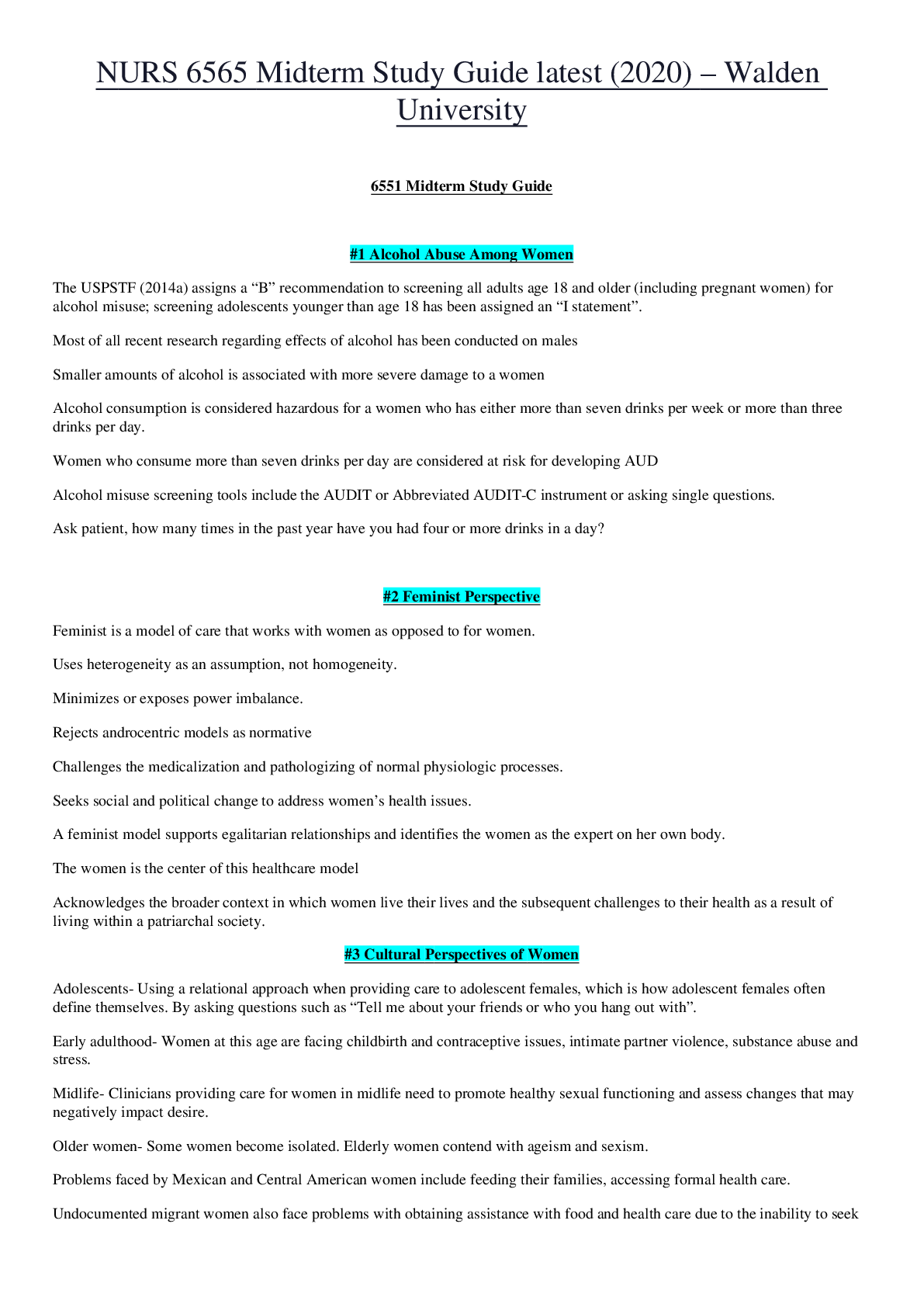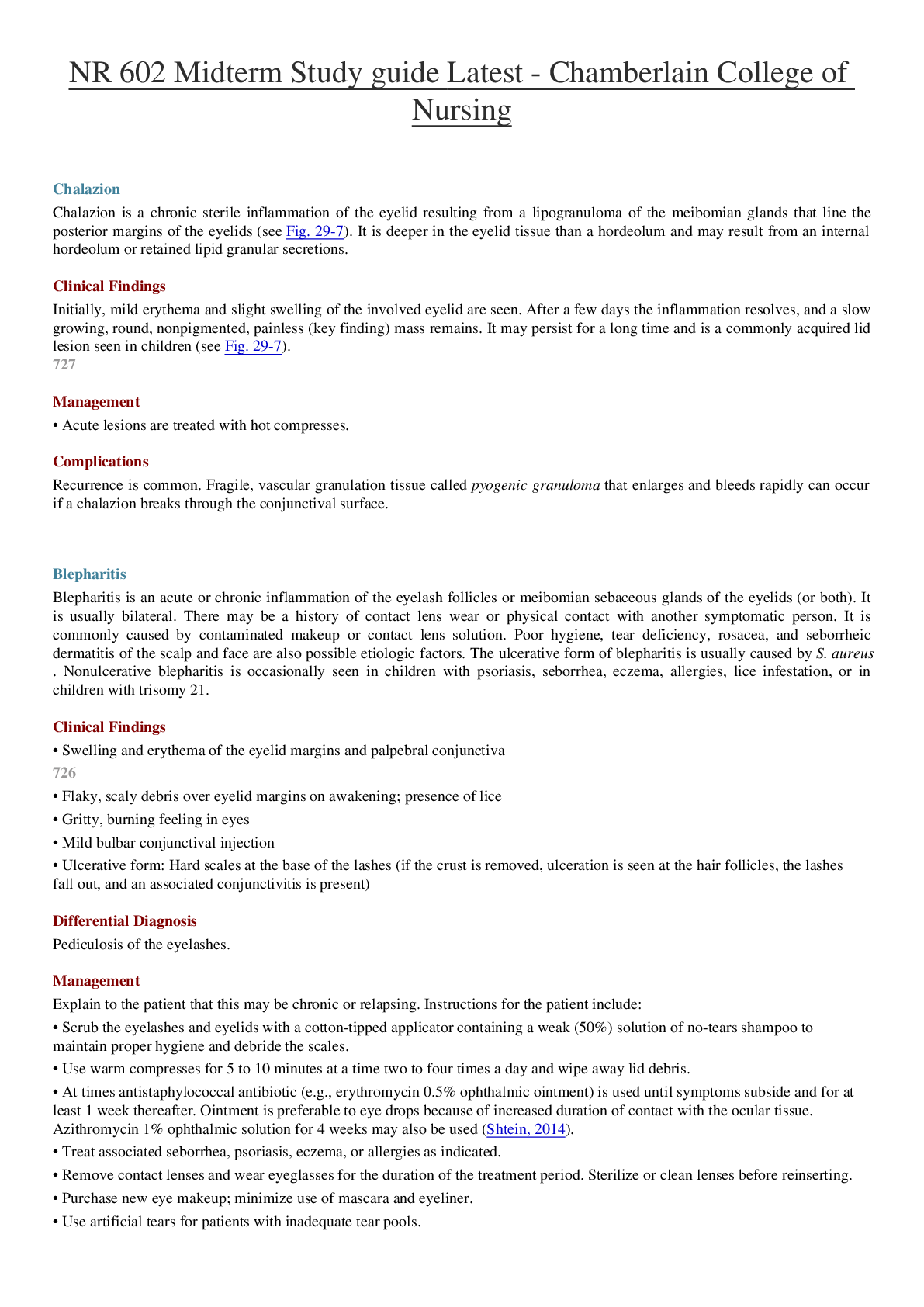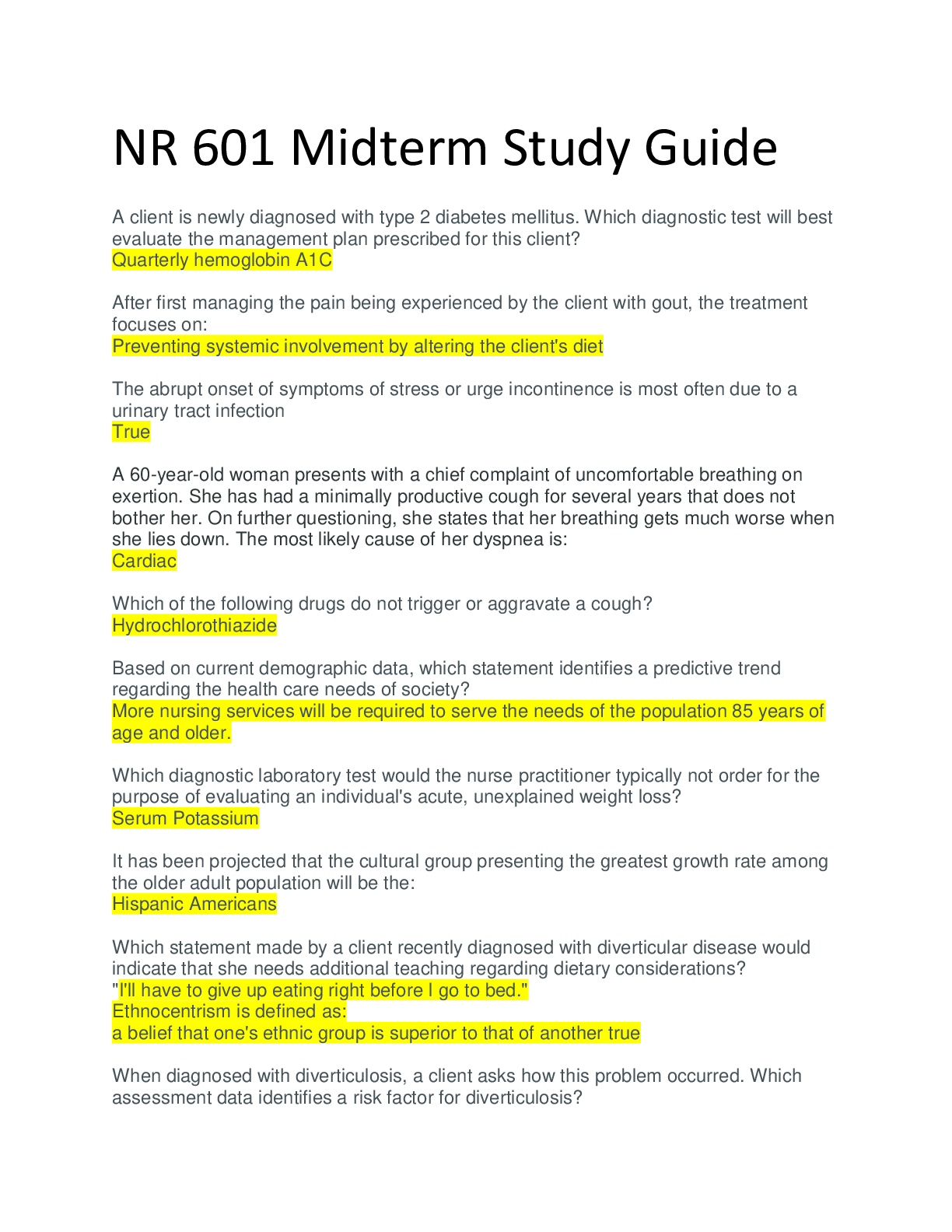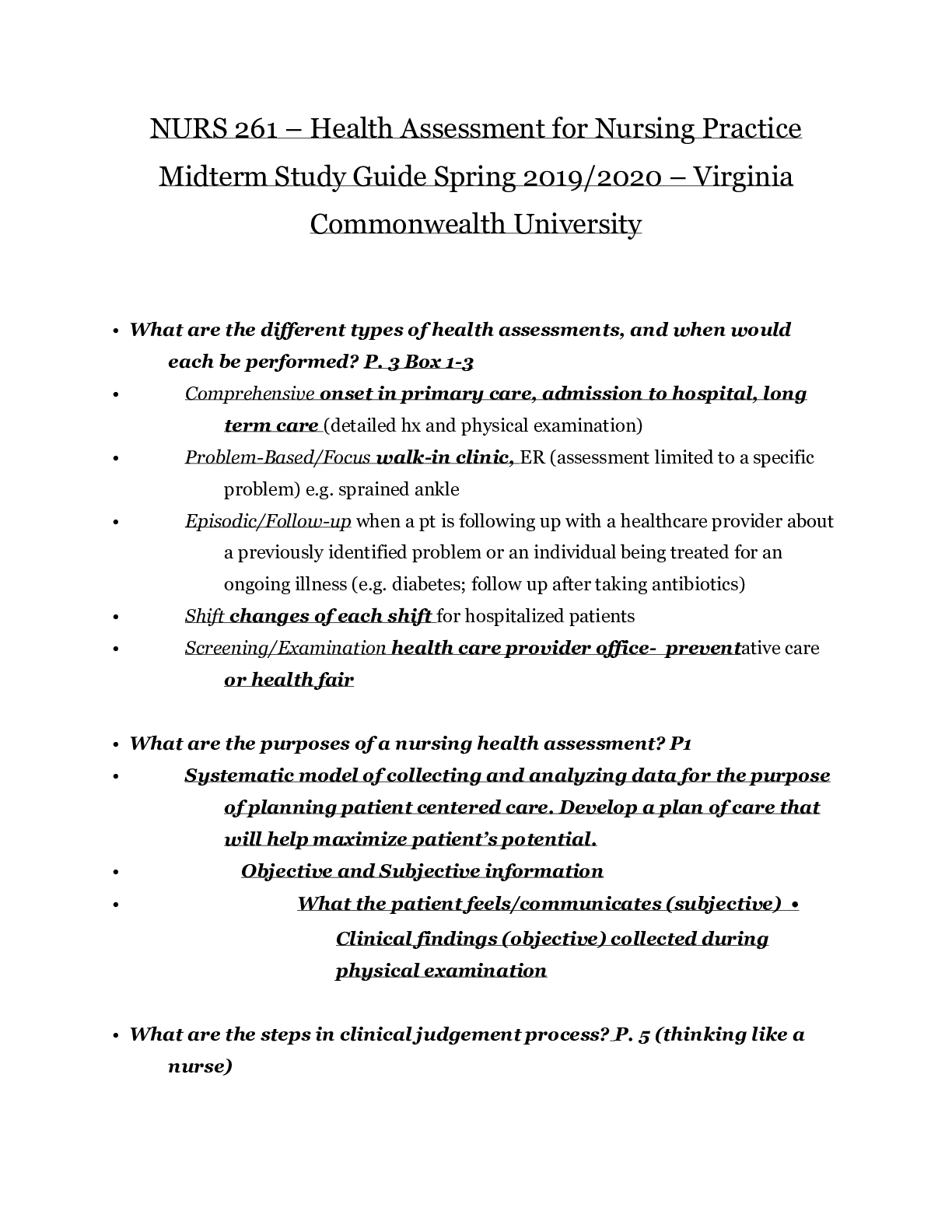*NURSING > STUDY GUIDE > NR 601 Midterm study guide 2021/2022_A Complete Guide For Exam Preparation-Graded A+ (All)
NR 601 Midterm study guide 2021/2022_A Complete Guide For Exam Preparation-Graded A+
Document Content and Description Below
NR 601 Chapter 1: Changes with Aging - Notes Fundamental Considerations - Recognize that presenting features of disease/illness may be different and having a greater awareness of the impact of chr... onic illness on the patient. - Perspective is different than with younger adults. Physiological Changes with Aging - The clinician must be aware that all the systems interact an, in doing so, can increase the older person’s vulnerability to illness/disease. - During the clinical decision-making process, the clinician knowledgeable about physiological changes with aging will be less likely to undertreat a treatable condition. -Example- Use the diagnostic process to differentiate the more benign seborrheic keratosis from actinic keratosis. - Be informed; do not attribute a finding to the aging process alone. The elder may conclude there is no point in changing behavior, because the process is inevitable. - Three primary points: 1) There is a reduced physiological reserve of most body systems, particularly cardiac, respiratory, and renal. 2) There are reduced homeostatic mechanisms that fail to adjust regulatory systems such as temperature control and fluid and electrolyte balance. 3) There is impaired immunological function: infection risk is greater, and autoimmune diseases are more prevalent. Laboratory Values in Older Adults - Many factors can influence lab value interpretation in the elderly, including the physiological changes with aging, the prevalence of chronic disease, changes in nutritional and fluid intake, lifestyle (including activity), and the medications taken. - Reference ranges therefore may be preferable. Reference ranges or intervals, such as age, sex, or race can be defined demographically. For example, the reference range for older adults might be the intervals within which 95% of persons over age 70 fall. - Further defined physiologically (fasting or activity status) or pharmacologically (medication, tobacco or ETOH use). - Biochemical individuality is of particular importance in detecting asymptomatic abnormalities in older adults. Significant homeostatic disturbances in the same individual may be detected through serial laboratory tests, even though all individual test results may lie within normal limits of the reference interval for the entire group. - The clinician must determine whether a value obtained reflects a normal aging change, a disease, or the potential for disease. - Misinterpretation of an abnormal lab value as an aging change can lead to underdiagnosis and undertreatment in other (anemia or UTI) and overdiagnosis and overtreatment in others (hyperglycemia or asymptomatic bacteriuria). - At times, the result of a lab value may be within the appropriate reference range yet indicate pathology for the older adult. - Calculation of creatinine clearance is important in the estimation of renal function. - Reduced renal function, particularly GFR, affects clearance of many drugs, and creat clearance provides an index of renal function for use in choosing doses of renally eliminated or nephrotoxic drugs (such as dig, H2 blocker, lithium, and water soluble antibiotics) - The Modiciation of Diet in Renal Disease (MDRD) and Cockcroft-Gault equations both provide useful estimates of the GFR. - Any risks involved in lab testing must be considered with respect to the patient’s clinical condition and weighedagainst the test’s expected benefits. Pharmacokinetic & Pharmacodynamic Changes - Polypharmacy and the potential for an adverse drug reaction (ADR) are major concerns in elders. - Polypharmacy primary predictor for an ADR (any unwanted response). - The therapeutic window narrows with age. The potential for benefiting the patient measured against risk of doing harm important. - Pharmacokinetics (what the body does to the drug) and pharmacodynamics (what the drug does to the body) alter the dynamic processes that drugs undergo to produce therapeutic effect due to the effects of the aging process. Absorption - Less impact than distribution, metabolism, elimination. - Gastric acidity declines with age; offset by the longer contact time that occurs as transit time slows – which is more functional than physiological. - Presence of food and other drugs in the stomach at the same time affect drug absorption. - Antacids and Fe can inhibit absorption. - Anticholinergic meds cause a slowing of colonic motility and can result in greater absorption rates. - Metabolic diseases, such as thyroid disease/DM can increase or decrease transit time, can cause either increased/decreased drug absorption. - When the med passes through the esophagus without adequate water, can cause erosion. Distribution - Drug distribution is affected by aging, particularly in individuals of smaller body size, decreased body water, higher body fat. - Drugs distributed in water have a higher concentration in elders, and exert a more profound effect. - Drugs distributed fat have a wider distribution and a lesss intense effect but a more prolonged action, particularly with more adipose tissue. - Drugs with a high protein binding rate have a greater potential to cause an ADR in those with less body mass. Fewer receptor sites, less albumin for binding, greater plasma concentration, more free drug is available for processes. - Protein bound drugs can reach toxic levels if the patient is not monitored closely. - Drug distribution relies on the bioavailability of the drug. - Amount of drug that reaches systemic circulation is increased/decreased based on: 1) Route of administration – drugs given IV/topically are more readily available than drugs admin IM/Subq/PO/rectally 2) Soluability of the drug is influential – aqueous solutions are available more quickly than oily ones 3) General circulation to the site of drug administration Metabolism Biotransformation occur sin all body tissues but primarily in the liver, where enzymatic activity (cytochrome P [CYP] system) alters and detoxifies the drug and prepares it for excretion. - Ability of the liver to metabolize drugs does not decline similarly for all meds. - Liver size and blood flow decrease with age, LFTs are typically normal when no disease exists. Can result in decreased first-pass metabolism. - Drug activity for some meds is prolonged, because drugs are metabolized and eliminated more slowly.- Knowing age-related pharmacokinetics of drugs is of utmost importance when determining the initial and maintenance dosages. - Critical to understand if a drug induces or inhibits the CYP system. Elimination - Most profound pharmacokinetic change. - Most rugs are excreted in the urine via the renal system, some are excreted in the feces via the biliary system. - Water soluble drugs are excreted directly by the kidneys. - Fat soluble drugs are concerted to water- soluble drugs by the liver first. - Changes in the kidney begin in the 4thdecade of life, continue to decline with each subsequent decade. - By 70, and individual may have a 40%-50% decreased renal function, even in the absence of disease – may prolong the half-life of drugs. - Important in drugs excreted unchanged in the urine and are nephrotoxic: aminoglycosides, radiocontrast materials, NSAIDs, ACEI. Pharmacodynamics - Explains the effect at the site of action and the time and intensity of the drug effect. - Elders have increased effects to drugs that affect the CNS – there is greater tissue sensitivity with aging. - Elders more likely to have ataxia with opiates. - Elders taking haloperidol more likely to experience extrapyramidal symptoms. - Elders may have increased tissue sensitivity for oral anticoagulants. - May experience decreased, rather than exaggerated response sometimes – i.e. beta blockers. Increasing drug dose may be needed. - Drug responsiveness may vary depending on the patient’s activity, stress level, environment. Presenting Features of Illness & Disease In The Elderly - Presenting symptoms can be very different than in younger adults. - Four factors affecting illness and disease: 1) Nonpresentation of illness 2) Multiple complaints 3) Altered pattern of illness 4) Atypical, nonspecific/vague symptoms or signs. - Underreporting of symptoms by older adults may occur if they attribute the new sign or symptom to age itself. If this is the case, they either fail to present to the health care provider or if they do, fail to challenge that it is normal part of aging. - Sometimes an acute symptom is superimposed on a chronic symptom, like pain or dyspnea – may not recognize it is as pathological and get treatment. - Advised to explore the possibility of a constellation of s/s that when analyzed may represent more than one condition/problem. - Depression should be considered- may manifest atypically – somatic complaints not uncommon. - Pattern of disease may progress differently (i.e. jaundice – suggestive of viral hepatitis in younger adult, gallbladder disease or malignancy in the elderly; delusions/hallucinations – bipolar disorder in younger individuals but dementia/medication side effects in the elderly). - Altered presentation is another common feature (i.e. confusion – UTI; depression – agitation and psychotic features; thyroid disease – cardiac symptoms). - Symptoms can be vague, nonspecific, modest changes should be investigated.Chronic Illness & Functional Capacity - Approx 80% of those aged >65 have one chronic disease, 50% have two or more. - Most common: heart disease, arthritis, respiratory problems, cancer, diabetes, stroke – impair functional capacity and limit ADLs and IADLs. Chapter 1: Changes with Aging - Review Questions [Show More]
Last updated: 1 year ago
Preview 1 out of 13 pages
Instant download
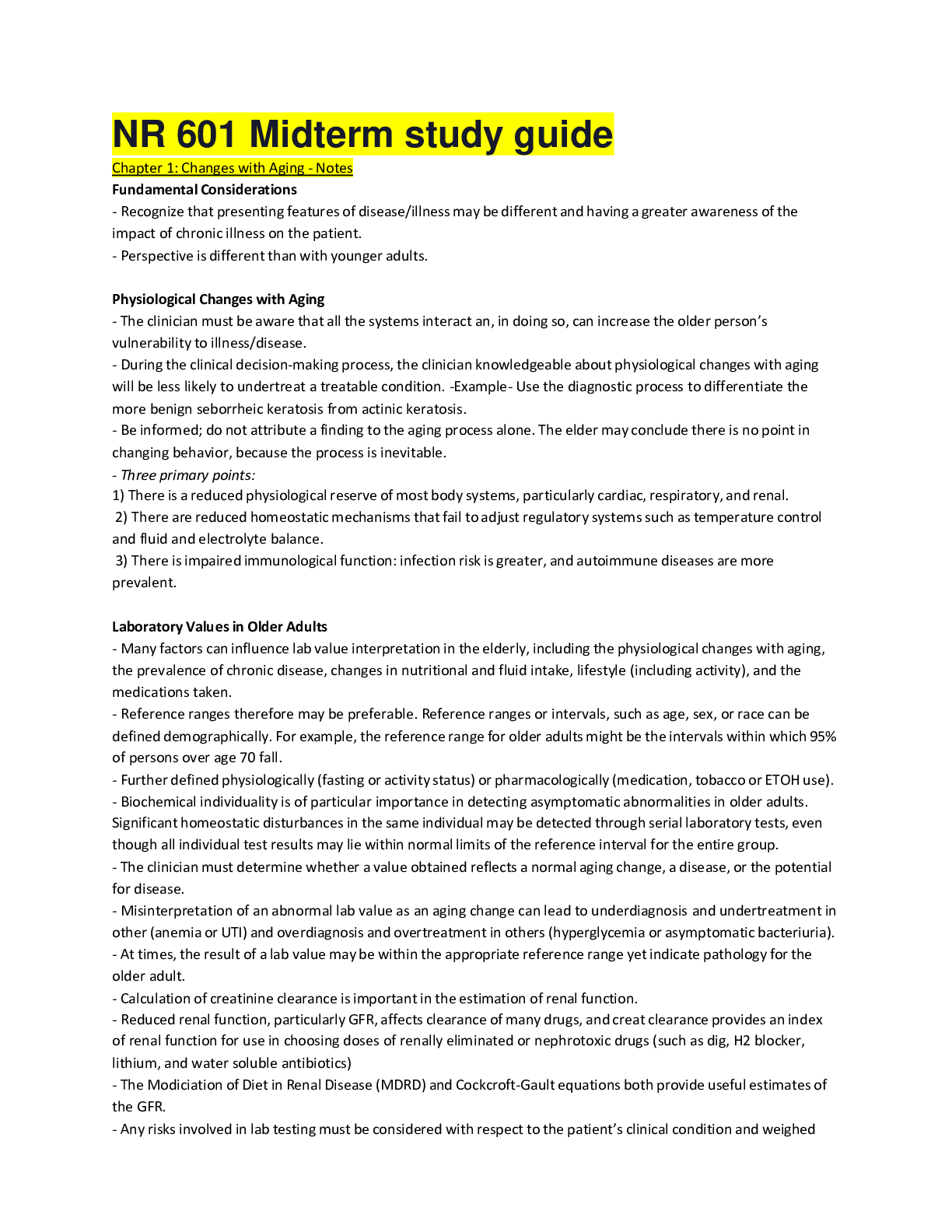
Buy this document to get the full access instantly
Instant Download Access after purchase
Add to cartInstant download
Also available in bundle (2)
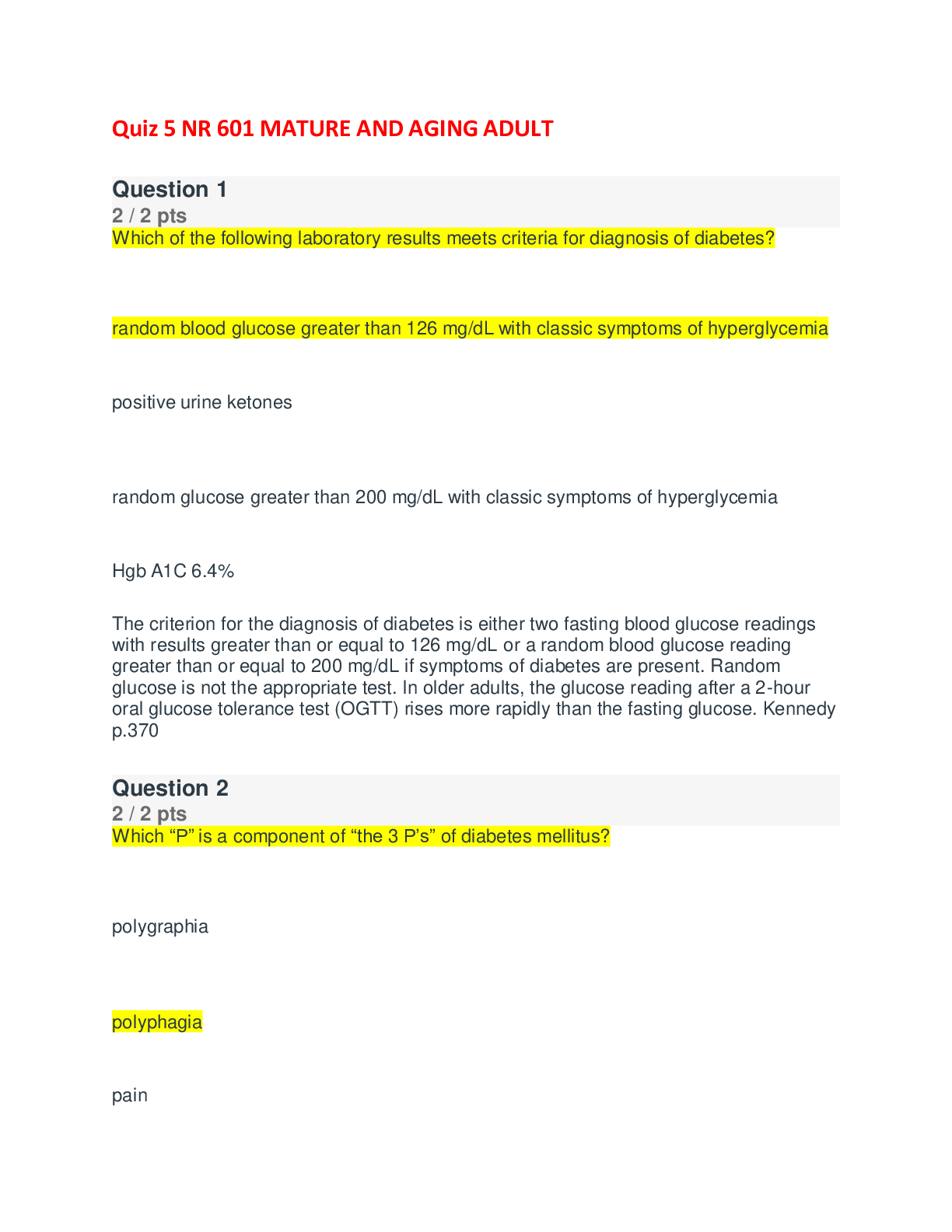
NR 601 Entire Course Week 1 – 8
NR 601 Entire Course Week 1 – 8 NR 601 Primary Care Of The Maturing And Aged Family Practicum (NR 601 Entire Course) NR-601 Week 1 Discussion Board: Polypharmacy (Initial Post, Faculty, Peer...
By d.occ 2 years ago
$49
25
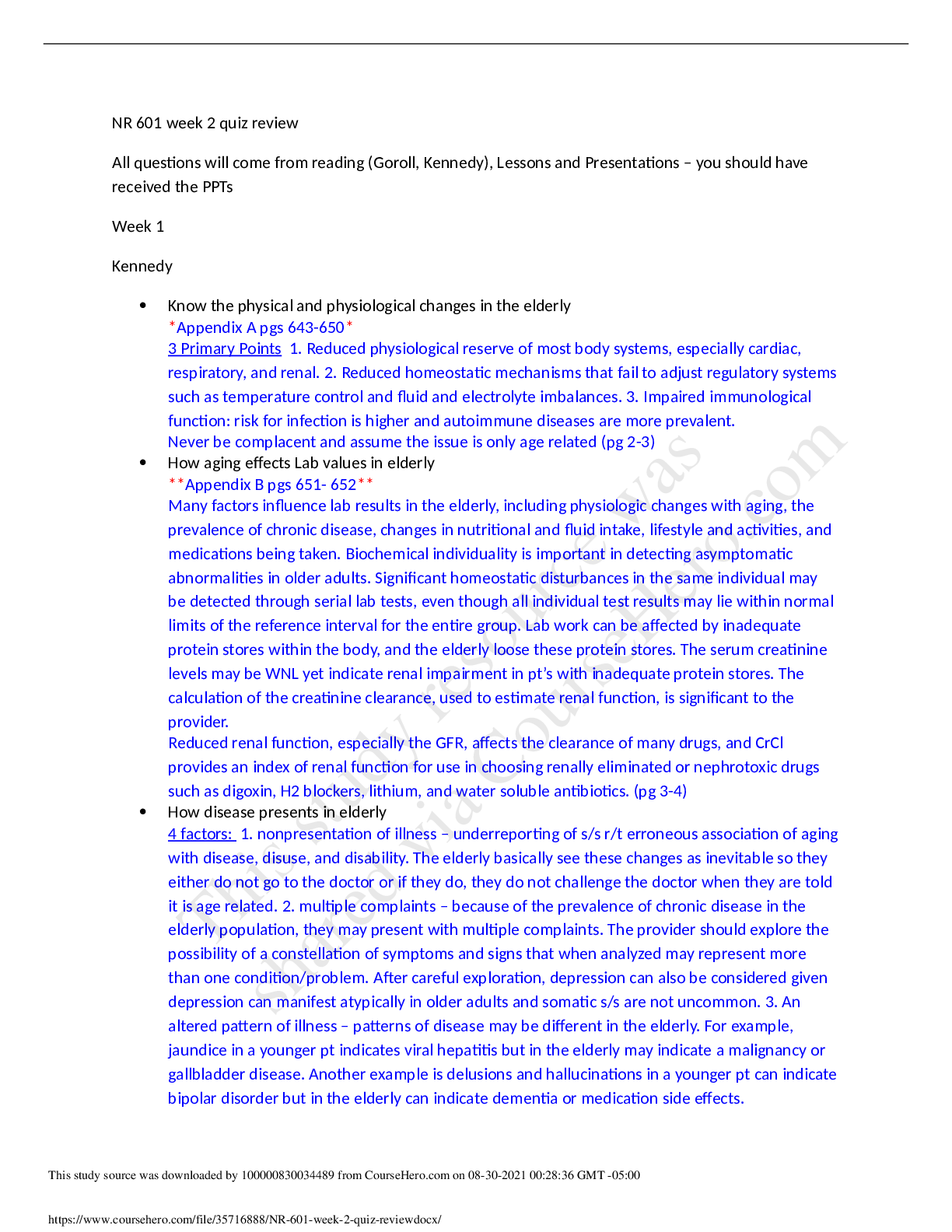
NR 601 Exam Material: Test Your Knowledge, Midterm, Final Exam
NR 601 Week 2 Test Your Knowledge NR-601 Week 3 Test Your Knowledge NR 601 Week 4 Midterm Exam Information: Questions-Answers NR-601 Week 4 Midterm Exam plus Study Material (Collection) NR 601...
By d.occ 2 years ago
$39
12
Reviews( 0 )
Document information
Connected school, study & course
About the document
Uploaded On
Jul 26, 2021
Number of pages
13
Written in
Additional information
This document has been written for:
Uploaded
Jul 26, 2021
Downloads
1
Views
119



